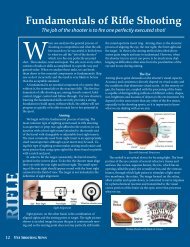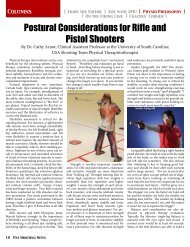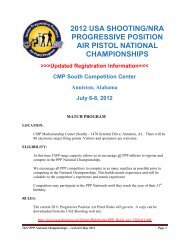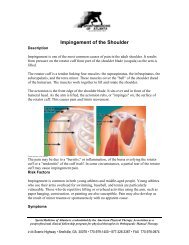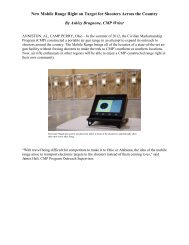November/December 2010: Volume 18, Number 6 - USA Shooting
November/December 2010: Volume 18, Number 6 - USA Shooting
November/December 2010: Volume 18, Number 6 - USA Shooting
- No tags were found...
Create successful ePaper yourself
Turn your PDF publications into a flip-book with our unique Google optimized e-Paper software.
In order to see the world around us clearly, the imageformed on the retina must be sharp. The normal eye at rest(or relaxed) is focused at infinity, so distant objects appear infocus, but nearby objects appear out of focus. To see closerobjects clearly, the ciliary muscle contracts reflexively tochange the shape of the crystalline lens to a more convex formincreasing the refractive power and bring the near object intofocus on the retina. This ability is called accommodation.Distant objects will now be out of focus. The eye cannot clearlyfocus on objects located at different distances at the same instant.While the reflex action of accommodation can take placequickly (especially in younger people when the crystalline lensis quite flexible) this puts a strain on the visual apparatus andmust be avoided.The eye also responds automatically to varying amounts ofambient light, by opening or closing the pupil via another reflexiveaction of the group of smooth muscles that controls theiris. This dilation or contraction of the pupil, called adaptation,regulates the amount of light entering the eye. The normalpupil opening ranges from a maximum of approximately eightmillimeters to a minimum of two or three millimeters. As weage, the maximum opening decreases to six millimeters makingit more difficult for older people to see at night. The pupilopening adapts much more quickly to increased illumination(a few seconds) than it does to a decrease in illumination(a few minutes). Therefore, it is critical to avoid looking atbrightly illuminated objects before or during shooting, and amajor reason flash photography is not permitted during shootingcompetitions.The action of the pupil is similar to the f-stop in a camera.The depth of field or the range of distances that the camera(eye) sees as being in focus increases as the f-stop aperture(pupil) size becomes smaller. The artificial pupil of the fixedrear aperture, or an adjustable rear iris, takes advantage of thisthereby allowing the shooter to increase the depth of field soall the elements of the sight picture are clearly seen in focus.Imperfections of the EyeAs a result of optical imperfections of the various componentsof the eye, the edges of the image produced on the retinaare not always perfectly clear. This is the ultimate limit of theresolution of the eye or visual acuity. However, under differingconditions of ambient light and/or fatigue, visual acuity is notconstant and can change.There are several inherent phenomena that occur as a resultof the eye being an optical instrument. The first is sphericalaberration, which occurs when parallel rays of light passingthrough the crystalline lens are refracted differently and thusnot focused at a single place on the retina. Light passing nearthe edge of the pupil, farther from the center of the opening,are refracted more than those passing through the center. Thisappears as a circle of diffused light rather than a sharp image.Spherical aberration is at a maximum when the pupil is openthe most. Image clarity can be improved if one can eliminatethe outer rays by either contracting the pupil or using an artificialpupil like that on the rear sight.Spherical AberrationA related problem is chromatic aberration. Visible lightis made of all the colors of the spectrum. When visible lightpasses through a lens, light in the blue and violet region refractsmore than that in the orange and red region of the spectrumfocusing each color at a slightly different point, causinga fringe or margin of colors to appear around the edges of theimage, especially around bright objects. This occurs becauselenses have different refractive indexes for different wavelengthsof light. Eliminating or reducing the amount of shorterwavelength (blue) light by a filter can improve image clarity.Chromatic AberrationAnother phenomenon occurs when light passes throughsmall openings, like the pupil or rear aperture, the rays bendand produce an image on the retina that is not a single point,but a circle surrounded by a number of concentric light anddark rings of decreasing brightness. This is called light diffractionand is due to the wave nature of light. Diffractionrings are only noticeable when the pupil is very small and isthe opposite of the cause of spherical aberration (large pupil).Diffraction effects are more noticeable when bright light isshining into the eyes causing the pupil to contract. Anotherdemonstration of diffraction is found when looking through asmall aperture. Looking carefully at the center of the opening,there seems to be a faint grey ring floating there, it is not dirtor fuzz, it is the diffraction pattern of the light.Light can also be diffused as it passes through the variouseye media, which are not absolutely transparent. Light diffusionmanifests itself as a radiance or weakly luminous hazecovering the field of vision, and is especially noticeable as ahalo of light around brightly illuminated objects against a darkbackground or when bright light enters the eye directly.Light irradiation is probably more applicable to pistolriflewww.usashooting.org 13Nov-Dec Issue <strong>2010</strong>.indd 1311/8/10 9:22 PM





